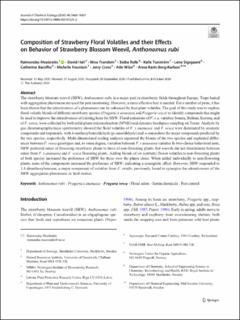Composition of Strawberry Floral Volatiles and their Effects on Behavior of Strawberry Blossom Weevil, Anthonomus rubi
| dc.contributor.author | Mozūraitis, Raimondas | |
| dc.contributor.author | Hall, David | |
| dc.contributor.author | Trandem, Nina | |
| dc.contributor.author | Ralle, Baiba | |
| dc.contributor.author | Tunström, Kalle | |
| dc.contributor.author | Sigsgaard, Lene | |
| dc.contributor.author | Baroffio, Catherine | |
| dc.contributor.author | Fountain, Michelle | |
| dc.contributor.author | Cross, Jerry | |
| dc.contributor.author | Wibe, Atle | |
| dc.contributor.author | Borg-Karlson, Anna-Karin | |
| dc.date.accessioned | 2021-01-26T15:43:27Z | |
| dc.date.available | 2021-01-26T15:43:27Z | |
| dc.date.created | 2020-10-26T11:52:29Z | |
| dc.date.issued | 2020-10-08 | |
| dc.identifier.citation | Journal of Chemical Ecology. 2020, 46 (11-12), 1069-1081. | en_US |
| dc.identifier.issn | 0098-0331 | |
| dc.identifier.uri | https://hdl.handle.net/11250/2724849 | |
| dc.description.abstract | The strawberry blossom weevil (SBW), Anthonomus rubi, is a major pest in strawberry fields throughout Europe. Traps baited with aggregation pheromone are used for pest monitoring. However, a more effective lure is needed. For a number of pests, it has been shown that the attractiveness of a pheromone can be enhanced by host plant volatiles. The goal of this study was to explore floral volatile blends of different strawberry species (Fragaria x ananassa and Fragaria vesca) to identify compounds that might be used to improve the attractiveness of existing lures for SBW. Floral emissions of F. x a. varieties Sonata, Beltran, Korona, and of F. vesca, were collected by both solid-phase microextraction (SPME) and dynamic headspace sampling on Tenax. Analysis by gas chromatography/mass spectrometry showed the floral volatiles of F. x ananassa. and F. vesca were dominated by aromatic compounds and terpenoids, with 4-methoxybenzaldehyde (p-anisaldehyde) and α-muurolene the major compounds produced by the two species, respectively. Multi-dimensional scaling analyses separated the blends of the two species and explained differences between F. vesca genotypes and, to some degree, variation between F. x ananassa varieties In two-choice behavioral tests, SBW preferred odors of flowering strawberry plants to those of non-flowering plants, but weevils did not discriminate between odors from F. x ananassa and F. vesca flowering plants. Adding blends of six synthetic flower volatiles to non-flowering plants of both species increased the preference of SBW for these over the plants alone. When added individually to non-flowering plants, none of the components increased the preference of SBW, indicating a synergistic effect. However, SBW responded to 1,4-dimethoxybenzene, a major component of volatiles from F. viridis, previously found to synergize the attractiveness of the SBW aggregation pheromone in field studies. | en_US |
| dc.language.iso | eng | en_US |
| dc.publisher | Springer Nature | en_US |
| dc.rights | Navngivelse 4.0 Internasjonal | * |
| dc.rights.uri | http://creativecommons.org/licenses/by/4.0/deed.no | * |
| dc.title | Composition of Strawberry Floral Volatiles and their Effects on Behavior of Strawberry Blossom Weevil, Anthonomus rubi | en_US |
| dc.type | Peer reviewed | en_US |
| dc.type | Journal article | en_US |
| dc.description.version | publishedVersion | en_US |
| dc.rights.holder | © The Author(s) 2020 | en_US |
| dc.source.pagenumber | 1069-1081 | en_US |
| dc.source.volume | 46 | en_US |
| dc.source.journal | Journal of Chemical Ecology | en_US |
| dc.source.issue | 11-12 | en_US |
| dc.identifier.doi | 10.1007/s10886-020-01221-2 | |
| dc.identifier.cristin | 1842254 | |
| dc.relation.project | Norges forskningsråd: 216158 | en_US |
| dc.relation.project | EC/FP7/249667 | en_US |
| cristin.ispublished | true | |
| cristin.fulltext | original | |
| cristin.qualitycode | 1 |
Files in this item
This item appears in the following Collection(s)
-
Divisjon for bioteknologi og plantehelse [523]
Publikasjoner knyttet til ansatte ved Divisjon for bioteknologi og plantehelse -
Publikasjoner fra CRIStin - NIBIO [4525]
-
Vitenskapelige artikler [1416]

